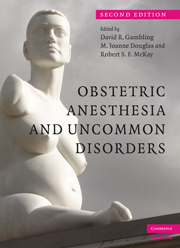Book contents
- Frontmatter
- Contents
- List of plates
- List of contributors
- Preface
- Section 1 Cardiovascular and respiratory disorders
- Section 2 Musculoskeletal disorders
- Section 3 Nervous system disorders
- Section 4 Metabolic disorders
- 13 Disorders of intermediary metabolism
- 14 Liver and renal disease
- 15 Malignant hyperthermia
- 16 Rare endocrine disorders
- Section 5 Other disorders
- Index
- Plate Section
- References
15 - Malignant hyperthermia
from Section 4 - Metabolic disorders
Published online by Cambridge University Press: 19 October 2009
- Frontmatter
- Contents
- List of plates
- List of contributors
- Preface
- Section 1 Cardiovascular and respiratory disorders
- Section 2 Musculoskeletal disorders
- Section 3 Nervous system disorders
- Section 4 Metabolic disorders
- 13 Disorders of intermediary metabolism
- 14 Liver and renal disease
- 15 Malignant hyperthermia
- 16 Rare endocrine disorders
- Section 5 Other disorders
- Index
- Plate Section
- References
Summary
Introduction
Malignant hyperthermia (MH) is an inherited disorder of skeletal muscle, which produces a hypermetabolic syndrome when susceptible individuals (MHS) are exposed to the triggering anesthetic agents. The known triggering agents are volatile anesthetics (halothane, isoflurane, enflurane, sevoflurane, and desflurane) and succinylcholine. They act by causing a sudden increase in intramyoplasmic calcium (Ca2+), which results in increased skeletal muscle metabolism. The diagnostic characteristics of acute MH are acidosis (combined metabolic and respiratory), muscle dysfunction (increased creatinine kinase [CK], myoglobinuria, rigidity, hyperkalemia) and evidence of inheritance. Although called malignant hyperthermia, marked elevation of temperature is often a late sign but may occur as early as 15 minutes following initiation of a volatile anesthetic agent in fulminant MH. The increase in intracellular Ca2+ may be due to a mutation in the ryanodine receptor such that the threshold stimulus for Ca2+ release is lowered or a defect in modulation at the receptor.
In a study of MH in susceptible swine, Ryan et al. demonstrated the sequence of events during a reaction. An increase in free myoplasmic Ca2+ precedes the increase in end-tidal CO2, followed by a decrease in arterial oxygen saturation (SaO2). These changes are followed by tachycardia and lastly hyperthermia. Dantrolene reversed these in the same order. Hypermetabolism (increased end-tidal CO2) begins when the intracellular Ca2+ increases above 0.6–0.7 μM, while muscle contracture and rigidity occur with a level above 1.0 μM.
MH and inheritance
MH is inherited in an autosomal dominant fashion with variable penetrance.
- Type
- Chapter
- Information
- Obstetric Anesthesia and Uncommon Disorders , pp. 269 - 274Publisher: Cambridge University PressPrint publication year: 2008



